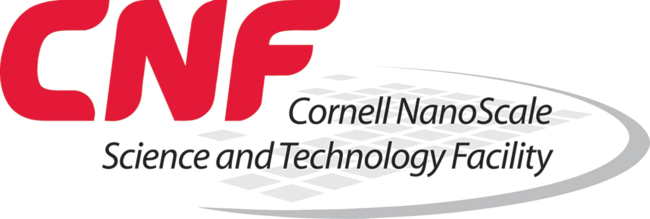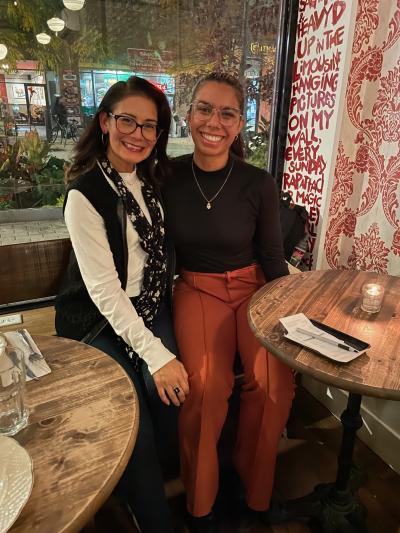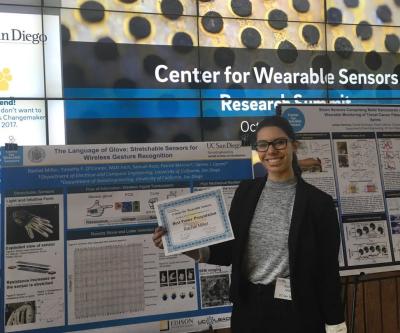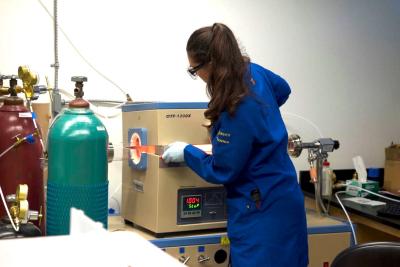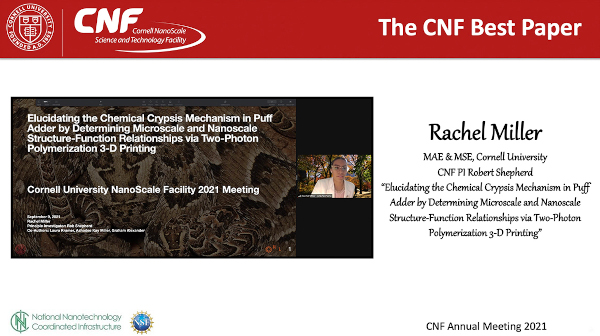
When Rachel Miller was in elementary school, she remembers being inspired by space science, and she aspired to be an astronaut. “I remember wanting to go to Mars, since we had already been to the moon,” she says. “I wanted to be the person who would make that next big step.” Also, an astronaut who would be a woman, a Latina, and the daughter of immigrants would be a first.
Now, she is particularly excited about nanoscience – the study of matter and systems at the nanoscale, where unique phenomena often occur. On the nanoscale, materials have physical, chemical, and biological properties different from those of bulk materials. Some of these “nanomaterials” are stronger or have different magnetic properties compared to their bulk forms, and others are better at conducting heat or electricity.
For the past five years, Miller has been working on ways to make new materials for wearables and soft robots. She enjoys finding creative solutions to difficult problems that can positively impact our daily lives. Sometimes, her ideas lead to dead ends; other times, her experiments fail miserably after months of hard work; and yet other times, she makes unexpected discoveries that bring her closer to the answers she is looking for. All this trial-and-error process is what makes her happy and keeps her in the laboratory late at night.
The path from aspiring astronaut to nanoscience researcher has been a long and winding road. In high school, Miller met teachers and mentors who would cultivate her scientific curiosity. In college, she took classes in science and engineering but also did scientific research with high-end instruments – such as electron microscopes, nanofabrication facilities, and x-ray and surface analysis equipment – through the National Nanotechnology Coordinated Infrastructure (NNCI), a national network of user facilities funded by the National Science Foundation. She was also supported by other researchers and staff at these facilities, which gave her the resources and the encouragement needed to succeed. These experiences increased Miller’s motivation for scientific research, particularly nanoscience, and encouraged her to pursue a graduate degree and then a Ph.D. in the field.
Gaining self-confidence in science
Miller grew up in Los Angeles. Her mother is from Nicaragua, and her father was born in the United States. When she was a young child, she enjoyed a variety of topics – visual arts, science, dance, history – and didn’t want to be cornered into one “type” of person or another. For example, when she was four years old, Miller started doing competitive figure skating, and she also trained in China with an exchange program. When she was 11 years old, she achieved one of the highest recognitions in U.S. figure skating as a gold medalist in “moves in the field.”
But continuously, she was put into the box of being “the creative,” “the girly,” and “the outgoing type,” which all contributed to people telling her that she didn’t belong in science and wasn’t the “engineering type.” However, her parents’ stories of sacrifice – whether being an immigrant who didn’t know a lot of English or a parent working three jobs to try to pay for college that didn’t end in a degree – drove her to excel in school and break into spaces for which she didn’t “fit the mold.”
“I definitely did not get that confidence or drive on my own,” Miller says. She often credits Rebecca Goldberg, her middle school science teacher, for showing her that being feminine and being smart weren’t mutually exclusive. “All of her labs were structured around an unusual but powerful storyline, albeit with a different plot each time: Scientist Barbie needed our help to save Ken by using the scientific method.”
In high school, Miller’s nanoscience and chemistry teacher, Daniella Duran, noticed how excited Miller was about nanotechnology. Miller actually felt she could be “a true and authentic version” of herself in a classroom in which her teacher was, like her, a Latina and first-generation college graduate. That nanoscience class was an honors class on advanced chemistry and nanoscience. It was a project-based class with hands-on learning, which suited Miller very well.
“I felt fortunate to have Ms. Duran as my teacher,” Miller says. “She was passionate about teaching and made it easier for me and my classmates to learn science.” All of the students in Duran’s class gave final research project posters at the end of the year, which were reviewed by local community members, peers, and volunteer graduate students and staff from the University of California, Los Angeles (UCLA).
“I loved the whole experience, from formulating experiments to designing a poster and presenting it,” Miller says. “Actually, that’s when I knew for sure that I wanted to go to college for nanoscience and later do a Ph.D.” Duran and Miller worked together to form a high school STEM club and created an outreach program modeled after programs from the National Nanotechnology Infrastructure Network – now the National Nanotechnology Coordinated Infrastructure (NNCI) – a network of user facilities across the United States funded by the National Science Foundation (NSF), to do interactive STEM demos in the community.
“Rachel is a powerhouse,” Duran says. “She was, and still is, very excited about the impacts of nanotechnology. Rachel embraced her natural curiosity to ask valuable questions and wanted to impact the world with science and technology as her creative vehicle.”
Nanoscience for underrepresented minorities
In the early 2000s, when Miller was a child, the United States made a national commitment to leadership in the emerging field of nanoscale science and technology through the creation of the National Nanotechnology Initiative (NNI). The NNI led to the creation and expansion of research facilities, like the NNCI, and created an environment to support the next generation of scientists and engineers.
For example, when Miller attended Duran’s nanoscience class, that class had just started. Many years prior, Duran had been developing that honors program based on her experiences at the Nanoscience Workshop for Teachers Program at the California NanoSystems Institute, which is located at the University of California, Los Angeles (UCLA), as well as a program called Research Experience for Teachers at the University of California, Santa Barbara (UC Santa Barbara), which was funded by the National Science Foundation until Sept. 1, 2014.
“My experience at UCLA and UC Santa Barbara opened up a solution to a problem that I saw as a teacher: the lack of representation from girls and people of color,” Duran says. “So, I created a nanoscience curriculum that showed the value (and complexity) of nanoscience, which drew in new talent and increased the representation of students.”
“Rachel was one of my first students in this new program, and we were partners,” Duran adds. “She and many fellow students were engaged and excited to participate in it. We were on a learning journey together.”
Because Duran’s class had a more diverse student population, many from underrepresented groups, Miller found a place where she belonged. “I asked students to take ownership of their own learning; providing a safe environment where all students were encouraged to take academic risks and could flourish from the authentic learning cycle of failure and iteration,” Duran says.
Duran credits her excitement for this high school program to Miller and the students who participated in her honors program the first year it was implemented. Twelve years later, Duran decided to focus on helping other teachers prepare their own programs. “I wanted to help more teachers do what I was doing, which is what I am doing now at Stanford University, where I am the director of education and outreach [within their NNCI facility],” Duran says.
Miller is happy to hear that the high school program that paved the way for her scientific career is alive and well. When she took the class back in 2011, “it was still experimental, yet it was more engaging and more stimulating than any other science class I took in high school then,” she says. “It made me excited to study nanoscience and solve scientific research problems.”
Doing research in nanotechnology
After graduating from high school, Miller applied to the University of California San Diego to major in nanoengineering. “UC San Diego is a large school,” she says. “I remember thinking the classes were really hard, but I didn’t want to let my own doubts stand in the way. I knew I wanted to go to graduate school and later teach nanoscience and be good at it, like Ms. Duran does.”
Miller started her first academic research project in the summer of 2015 through the Research Experience for Undergraduates (REU) program at Harvard’s School of Engineering and Applied Sciences, which enables undergraduate students to spend their summer at Harvard University performing cutting-edge research in world-class laboratories.
Throughout the rest of her undergraduate education, Miller took classes in polymer science, nanofabrication, and characterization. But it was her work as a UC LEADS (UC Leadership Excellence through Advanced Degrees) Scholar in the research group of Darren Lipomi, a Professor of NanoEngineering at UCSD, that enabled her to take on large engineering problems and responsibilities. As an undergraduate student, Miller worked for three years in Lipomi’s research group, making scientific advances related to wearable electronics, such as a gesture-interpretation glove and wearable swallowing sensors with carbon nanomaterials.
During this time, Miller worked at the San Diego Nanotechnology Infrastructure (SDNI), where she was able to image and fabricate sensors at the nanoscale. SDNI is part of the NNCI and part of larger network of user facilities funded by other government agencies, such as the U.S. Department of Energy, the National Institutes of Health, and the National Institute of Standards and Technology. This larger network is supported by the NNI.
“Being part of the nanotechnology community gives you a sense of belonging, because this community already includes people from various disciplines, so being different and bringing different perspectives is valued,” Miller says. “Nanotechnology is not its own distinct field. It’s a completely different way of looking at problems. Also, the tools and techniques used to work in nanotechnology open up many possibilities.”
“As an undergraduate student, Rachel was always ebullient and very friendly,” Lipomi says. “She has developed a lot of confidence in her skills over the years. I met her recently, and she is very excited about her research work. I think Miller has always been on a good professional trajectory, and now, she is flourishing.”
Miller was also actively involved in IDEA (Inclusion, Diversity, Excellence, and Achievement) at UCSD. She was accepted into the IDEA Scholars program, which provides academic support to students with low socioeconomic status, which are often underrepresented minorities or at-risk populations. Miller was also selected to provide the commencement speech at an IDEA Graduate Recognition Ceremony upon her graduation in 2018.
Says Lipomi, “It wasn’t easy for Rachel when she started at UCSD, but over time, she realized she wasn’t alone. Hopefully, Rachel will inspire other minority students who have challenges when they start in college.”
New interests and opportunities
After graduating from UCSD, Miller went to Cornell University to pursue a Ph.D. in materials science in the group of Rob Shepherd, Associate Professor of Mechanical and Aerospace Engineering. For her research work, Miller studied how the skin surface structure of a South African snake makes them invisible to smell. She used many resources from the Cornell NanoScale Facility, which is also part of the NNCI network of user facilities, to 3D-print replicas of skins and capture images of these skin replicas with an electron microscope. For another project, she developed a surface-coating process to create stretchable and wearable light-based sensors.
“The interdisciplinary work in this group was exciting,” she says. “Because of the vastly different scientific backgrounds of the members of the group, it’s important for me to communicate well what I am doing. It’s like speaking different languages. I need to make sure my colleagues really understand what I am saying.”
She adds that the diversity of perspectives from her colleagues also helps her think more critically, so she can say to herself: “Maybe I could do this this way or this other way.”
“Nanotechnology is a different way of doing science and engineering – at least compared to more traditional, siloed fields of science or engineering,” Miller says. “It’s an effective way to get a cross-sectional view of different fields. Not only do nanoscientists look at problems from a holistic perspective, but they also look at more complex problems that require a multidisciplinary perspective.”
Through her experience, Miller has also realized that studying nanoscience, and science, more broadly, is open to everyone; it leads to effective solutions and creates opportunities for other underrepresented students, like her. By doing so, she would like to show minority women that opportunities to pursue a STEM career do exist, and although obstacles occur, they shouldn’t stop them from pursuing their passions and dreams.
Miller completed her Ph.D. a few months ago (in June 2023). Now, she is considering becoming a teacher, and she has many ideas on how she would like to teach science. “I love working with students,” Miller says. “I would like to teach science and engineering not just as part of a curriculum, but also as a lens to find solutions to problems. I’d like to have experts come and talk with students, not at students. I would also like to get students in research labs, so they can appreciate the value of teamwork in science. And I would like to show them how to be community facilitators.”
Back when she was a high school student, Miller had no idea what her college adventure was going to look like. She knew at the time that she liked science. But being a girl and a minority, she thought, “Where could science take me?” Thanks to all the support and encouragement from her teachers, mentors, classmates, and friends, she has now been able to forge her own path, and she knows that your gender, your background, or how people label you don’t matter if you have the right support and if you believe in yourself. “Nanoscience is for everyone!” she says.
